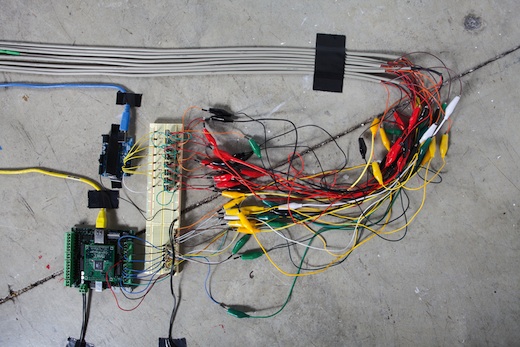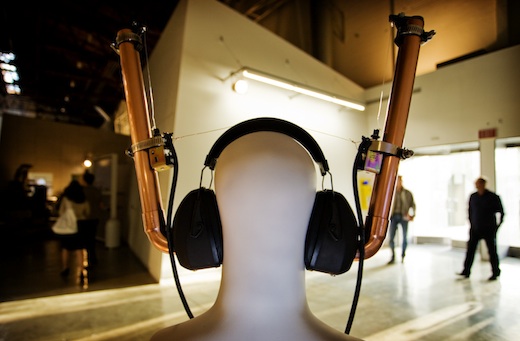Looking for that “Imagine If” Question: An Interview with Interaction Design Department Chair Maggie Hendrie
This coming Fall Term, as part of the College’s Create Change initiative, Art Center launches a new undergraduate Interaction Design degree program, in which students will learn to think deeply about user experience, apply technology creatively and invent new approaches to interaction and design.
We recently sat down with Interaction Design Department chair Maggie Hendrie and asked her what prospective students should know about the new program.
Dotted Line: What is Interaction Design?
Maggie Hendrie: People interact with every object or system in their world, whether it’s human-made or natural. Interaction design is the process and craft of how people interact with artifacts, systems and services. We see this everywhere today in mobile apps, electronics, web sites, games, social networks and public spaces. Interaction design focuses on the user experience; how real people think, feel and behave when they use a product, environment or system.
Does Interaction Design go beyond working with technology?
Absolutely. What’s important is that you care about people and their experiences. You need to be able to ask, “What’s valuable and meaningful for people?” And then you need to be able to blueprint, wireframe, sketch or model what a solution to a problem might look like.
How does the technological aspect of the discipline play out in the classroom?
Students learn programming and technical skills to a certain degree: they need to experience it and understand how technology enables and shapes user interaction. For some students, programming will become their passion—and perhaps they’re choosing this path because it already is. But for others, once they understand it enough to know what the person programming needs from them, they will be better able to communicate their vision to others who are expert in specific technologies that bring the product or system to life.
I wouldn’t want students to constrain their vision based solely on what they know how to program. That would be very limiting—like saying to an architect, “I only want you to design a building that you can build with your bare hands.” So, again, you don’t need to be a technologist to be an interaction designer, but you must not be afraid of technology, either. In the classroom, technology is part of hands-on, transdisciplinary studios and labs so students become familiar with tools in the context of real projects, often with industry partners.
In terms of process, what do Interaction Designers do?
Interaction designers find alternative ways of understanding, describing and solving problems in areas such as work, play and lifestyle. As designers, we don’t wait for people to tell us what they want us to create. We start by observing—watching what people do in their world. We’re always looking for insights that bring us to that “imagine if” question. And every step of the way, we’re envisioning the people who we’re designing for—What are they thinking? How are they feeling? What are they doing? A lot of innovation comes from empathizing, then prototyping different kinds of solutions.

Current Grad Media Design student Salvador Orara's Tonalis Luminous, tonal, light-sensitive flowers.
What type of person is drawn to Interaction Design?
As humans, we’re constantly interacting with objects, environments, systems, institutions and other human beings. Interaction designers genuinely believe the way people interact with their world deeply influences their quality of life.
How does Interaction Design differ from other types of design?
In many design fields the focus is on the finished piece; impeccable and beautiful—it’s complete and I can display it. However, when one makes something interactive, it doesn’t fully exist in the world until somebody is interacting with it. So there’s a form of co-creation with the end user. And that can lead us into unexpected directions.
For example?
Who knew, when they were handed what was initially conceived as a next-generation music player, that kids would start podcasting? That’s where the observation part of the process comes back in to play. In that sense, interaction design is closely linked with product design, particularly when it comes to the concept of a product roadmap, and observing how the user’s relationship with the object changes over time. It comes down to relationship design. The example I like to point to is ubiquitious banking—our relationship with banks has completely changed due to ATMs and online banking. All our relationships with institutions and other people are changing.

Alex Braidwood's MDP 11 Noisolation Headphones at last year's 4 Hours Solid graduate programs event. Photo: Four Eyes Photography.
Why study Interaction Design at Art Center?
Art Center has a long history of maintaining the dynamic between the development of a craft and the application of it, and interaction design is an applied craft. We believe there is a core set of skills, craft and activities that will make people good at interaction design. Also, Art Center is already outstanding in the very fields in which interaction is applied: environments, interfaces, products, automotives, social projects and systems.
In terms of curriculum, what can students expect from your program?
Some people hear “interaction design” and think that means they’ll be learning how to design an iPad app. And along the way they will, but our goal is for students to become very literate in interaction. They should be able to talk about interaction design the same way their colleagues talk about every other type of design. When they first start out, they can expect to get very good at modeling, sketching, paper prototyping and thinking of creative ideas to convey an experience without having to build it out in whole. We will also offer our students Transdisciplinary studios where they’ll be able to bring ease-of-use, beautiful interfaces and really coherent interaction to the disciplines to which it gets applied.
Where do you expect students to ultimately apply what they learn here?
We have high expectations for what our students will do in a variety of industries. In Southern California alone we have the worlds of startups, apparel, furniture, toys, gaming, automotive, biotech and entertainment. But our goal isn’t to simply create bodies to fill the jobs available in those fields. We want our students to define those fields and bring innovation to the people and companies where they work—to become creative visionaries for those industries.
Art Center is now accepting applications for students entering the Interaction Design program. For more information, call Admissions at 626.396.2373 or visit artcenter.edu/ixd










